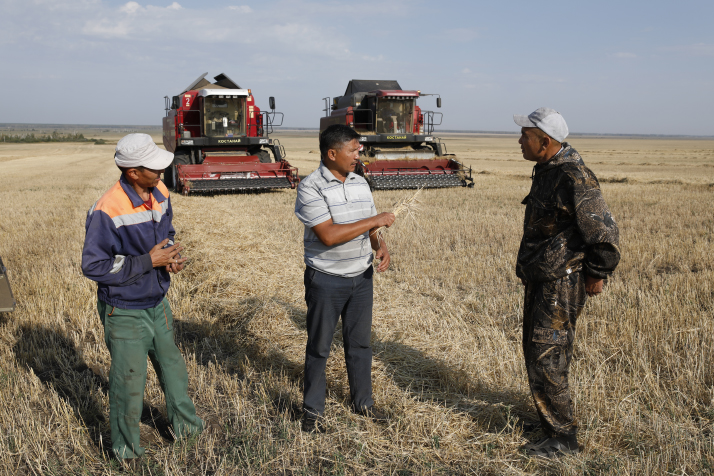| Xinjiang Today |
| Championing the China-Central Asia spirit | |
|
|
 A participant practices calligraphy at an event celebrating the International Chinese Language Day in Almaty, Kazakhstan, on April 19 (XINHUA)
The China-Central Asia Spirit embodies the core values of bilateral cooperation and serves as a concrete regional expression of the vision of a community with a shared future for humanity. Its outlook on civilization and development has resonated widely across the international community, sparking reflection on new models of global governance.
At the Second China-Central Asia Summit in Astana, Kazakhstan, on June 17, President Xi Jinping delivered the keynote speech titled Championing the China-Central Asia Spirit for High-Quality Cooperation in the Region. For the first time, he systematically articulated its principles: "mutual respect, mutual trust, mutual benefit and mutual assistance for the joint pursuit of modernization through high-quality development." This framework refines the values underpinning cooperation while offering a vivid demonstration of China's broader vision for shared progress.  A Chinese doctor conducts ophthalmological examinations for a patient in Dushanbe, Tajikistan, on June 12, 2024 (XINHUA)
New model of regional cooperation The concept of a new type of international relations, based on mutual respect, fairness and justice, and win-win cooperation, breaks away from the power politics and zero-sum mentality that have long defined global affairs, offering a new theoretical framework for reshaping the world order. China's engagement with Central Asia illustrates this theory in practice, evolving from an abstract concept to concrete action. At the civilizational level, it emphasizes respect for the cultural uniqueness and the independent development paths of Central Asian nations, fostering a dialogue mechanism that values harmony without uniformity. On the multilateral stage, frameworks such as the United Nations and the Shanghai Cooperation Organization (SCO) provide platforms for safeguarding fairness and justice in international affairs, and opposing the politicization of human rights. The SCO, originally consisting of China, Russia and four Central Asian countries, has become the world's largest regional organization in terms of geographical coverage and population. It now has 10 member countries and 16 observer states and dialogue partners. In practical cooperation, landmark projects such as the China-Kazakhstan oil pipeline and the China-Kyrgyzstan-Uzbekistan Railway currently under construction highlight resource complementarity and shared interests. From the early border trade to the deep integration achieved under the Belt and Road Initiative (BRI), cooperation has steadily advanced, demonstrating the institutionalization of this new model of international relations. The BRI is a China-proposed initiative aimed at boosting connectivity along and beyond the ancient Silk Road routes. The vision of global governance rooted in extensive consultation, joint contribution and shared benefits broadens the theoretical boundaries of regional collaboration. China and Central Asian nations align their development strategies under the BRI framework. Cooperation now extends to technology transfer and talent cultivation, enhancing local capacity for development and transcending traditional aid paradigms. Together, both sides work to promote progress by encouraging exchanges that go beyond estrangement, mutual learning that evades conflict and inclusiveness that sidesteps notions of superiority. Political trust, shared development and close people-to-people ties stand as the three pillars of China-Central Asia cooperation, providing stability and resilience for regional cooperation. From converging interests to common values Trust between China and the five Central Asian countries has evolved in stages. Early ties were built on economic cooperation serving as the bond. The establishment of the SCO institutionalized mutual trust, making cooperation more structured. The BRI then elevated bilateral relations to the level of strategic coordination, signaling a qualitative shift from convergence of interests to alignment of values. Mutual respect affirms civilizational equality, providing an ethical basis for the coexistence of diverse cultures. Mutual trust overcomes zero-sum thinking, fostering a psychological contract for sustainable cooperation. Mutual benefit anchors the pursuit of shared prosperity, building a durable mechanism for interest convergence. Mutual assistance mobilizes collective strength to confront challenges and reinforces the consciousness of a shared future. Aligned with the China-proposed Global Development Initiative (GDI), the China-Central Asia Spirit reflects both sides' pursuit of equality and modernization, providing a lasting momentum for bilateral relations. Regional application of the GDI Effective alignment of development strategies is central to bringing the GDI into practice at the regional level. The GDI aims to meet the long-term objectives and immediate needs of the world's common development, fostering international consensus on how to promote development, cultivating new drivers for global growth and facilitating the progress of all countries. At the Second China-Central Asia Summit, an action plan for high-quality Belt and Road cooperation was unveiled. Initiatives like a joint entrepreneurs' committee are expected to optimize resource allocation, boost cooperation efficiency and strengthen the region's capacity to withstand risks. The three new cooperation centers on poverty reduction, educational exchange and desertification control mark a new capacity-building model. The poverty reduction center shares China's targeted poverty alleviation experience with Central Asia with the aim of building effective poverty reduction systems, while the desertification control center promotes joint responses to environmental challenges through technology sharing. These initiatives go beyond short-term interests by strengthening local capacity and adding momentum to sustainable development. At a time when unilateralism is heightening risks to global supply chains, achievements such as smoother trade and upgraded investment agreements offer regional solutions for multilateralism and contribute ideas for global value chain governance. Exchange between civilizations People-to-people exchanges remain vital for bridging divides and advancing cooperation. In Central Asia, the China-Central Asia Cooperation Forum embeds the vision of a shared future in cultural dialogue. Confucius Institutes offer local youth a window into China, visa facilitation boosts tourism and people-to-people ties, and growing sister-city networks are expanding exchanges across diverse fields. Confucius Institutes, named after ancient Chinese philosopher and educator Confucius (551-479 B.C.), are nonprofit public institutions designed to help people in other countries better understand China by teaching the Chinese language and culture at universities in their host countries. The Second China-Central Asia Summit outlined a framework for cultural cooperation driven by government leadership, public participation and market synergy. Governments are building long-term mechanisms through cultural centers and university branches, while people-to-people initiatives, such as youth entrepreneurship and artistic performances, create enduring platforms linking the economy and culture. The signing of the treaty on eternal good-neighborliness, friendship and cooperation by China, Kazakhstan, Kyrgyzstan, Tajikistan, Turkmenistan and Uzbekistan during the summit codifies the principle of enduring friendship in legal form, strengthening the social foundations of political trust and development cooperation.  Farmers harvest wheat to be sold to a Chinese company in North Kazakhstan Region, Kazakhstan, on September 2, 2022 (XINHUA)
Future outlook The outcomes of the summit serve as a practical validation of China's theoretical innovation in neighborhood diplomacy and demonstrate a successful regional application of a new type of international relations and the GDI. They provide a model for developing countries to overcome the center-periphery dilemma and pursue shared growth. Looking ahead, China and Central Asian countries will focus on three priorities: strengthening political trust through high-level exchanges to consolidate strategic coordination, promoting industrial cooperation to raise the quality of development, and deepening people-to-people exchanges to foster mutual understanding. As engagement deepens, the global significance of China-Central Asia cooperation will become increasingly evident, adding new chapters to the building of a community with a shared future for humanity. China's cooperation with Central Asia shows that genuine regional cooperation rests on intercivilization exchange, pursues common development and is guided by a shared future. The articulation and practice of the China-Central Asia Spirit bring new vitality into the region and send a clear message to the world: The vision of a community with a shared future for humanity, transcending ideological divides and focusing on common interests, is not only viable but is already becoming a reality. The author is an associate professor at Kashi University Comments to liangxiao@cicgamericas.com |
|
||||||||||||||||||||||||||||||
|